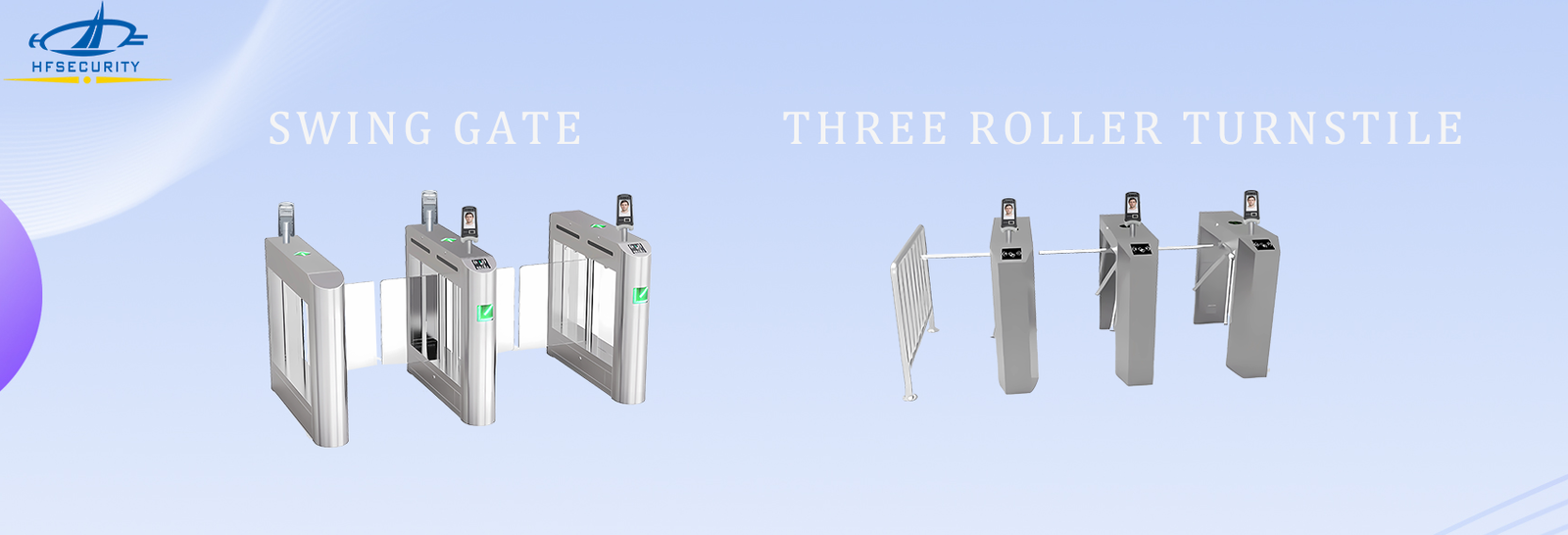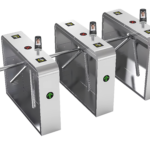
Swing gates and three roller turnstiles are pivotal in modern access control, each excelling in distinct scenarios. While swing gates prioritize high-traffic flow and accessibility, three roller turnstiles focus on strict security and space efficiency. This article breaks down their key features and ideal use cases to guide your selection
Functional Characteristics
Swing Gate
1.Design
Horizontal barriers that swing open and closed provide a wide passage, typically ranging from 800 to 1200mm, making them ideal for accommodating wheelchairs, strollers, or luggage. These barriers ensure smooth, effortless access in high-traffic areas, offering both functionality and convenience while maintaining security. Their design enhances inclusivity by allowing easy passage for individuals with mobility challenges or those carrying bulky items.
2.Safety
Equipped with infrared sensors, these barriers can detect collisions and automatically reverse direction to prevent potential injuries. The sensors help ensure that if an obstacle is detected in the path, the barrier will stop or change direction to avoid harm. This feature significantly enhances safety, making the system safer for both users and passersby. It is especially useful in environments with high foot traffic or where children and elderly individuals are present.
3.Speed
Capable of processing over 40 people per minute, this system is designed for high-traffic environments like airports, stadiums, and large events, where rapid throughput is essential. It efficiently handles large crowds, reducing wait times and improving overall user experience, while maintaining high security standards. This speed ensures smooth flow even during peak times, making it ideal for venues with high foot traffic.
4.Durability
The stainless steel construction is highly durable and resistant to corrosion, making it ideal for outdoor environments exposed to harsh weather conditions. Whether subjected to rain, humidity, or extreme temperatures, the material maintains its structural integrity and appearance, ensuring long-lasting performance and minimal maintenance. This makes it perfect for use in parks, entrances, and other outdoor locations where exposure to the elements is a
Three Roller Turnstile
1.Mechanism
The three rotating arms of the turnstile restrict passage to one person at a time, effectively enforcing strict entry control and ensuring that only authorized individuals can enter. This feature is particularly useful in high-security areas, preventing unauthorized access while maintaining smooth flow. The design also prevents crowding, providing a more organized and secure entry process, ideal for environments like offices, stadiums, or transit stations.
2.Security
The system prevents tailgating by using mechanical locking and anti-reverse technology, ensuring that only one person can pass through at a time. When an individual enters, the locking mechanism activates to secure the turnstile, while the anti-reverse feature stops any attempt to re-enter or reverse direction. This enhances security by eliminating unauthorized access and ensuring strict control over entry points, making it ideal for sensitive or high-security areas.
3.Space-Saving
With a compact footprint of less than 600mm in width, this turnstile is perfectly suited for narrow entrances, such as those found in subway stations, airports, or office buildings. Its space-saving design ensures efficient use of limited space while maintaining functionality and security. This allows it to seamlessly fit into areas with tight or confined spaces, ensuring smooth flow and easy access without compromising on performance.
4.Material
Constructed from cast iron or alloy steel, these turnstiles are built to withstand high-impact forces, ensuring long-term durability even in 24/7 operations. These materials provide exceptional strength, making the turnstile resistant to damage from frequent use, vandalism, or accidental collisions. Ideal for high-traffic environments like transportation hubs or commercial facilities, this robust construction guarantees reliable performance and minimal maintenance over time.
Application Scenarios
Swing Gate
1.Airports/Train Stations:
Designed to accommodate travelers with bulky luggage, these turnstiles ensure a smooth and efficient flow through entry points. The wider passageway allows for easy navigation of suitcases, strollers, or other large items without hindering the movement of other passengers. This feature is particularly beneficial in airports, train stations, and bus terminals, where efficiency and convenience are essential for travelers on the go. It reduces bottlenecks and enhances the overall travel experience.
2.Corporate Offices
The turnstile system is ADA-compliant, providing accessible entry for employees and visitors with disabilities. It ensures that individuals with mobility challenges, including those using wheelchairs or other mobility devices, can pass through easily and safely. This inclusive design promotes equal access, meeting regulatory standards while maintaining security and smooth traffic flow in all environments.
3.Exhibition Halls
The system is designed to enable rapid entry during peak hours, effectively managing high volumes of people without creating bottlenecks. With features like high-speed processing and efficient access control, it ensures smooth, uninterrupted flow even during busy times. This is particularly beneficial in high-traffic areas such as airports, stadiums, and office buildings, reducing wait times and improving overall user experience.
Three Roller Turnstile
1.Subway Stations
The system enforces a strict one-person-per-entry policy in crowded transit hubs, preventing overcrowding and ensuring smooth, controlled access. By limiting entry to one individual at a time, it maintains security and order, reducing the risk of unauthorized entry or tailgating. This feature is especially valuable in high-traffic areas like subway stations, train terminals, and airports, where efficient crowd management is essential for safety and smooth operations.
2.Factories/Data Centers
The Three Roller Turnstile prevents unauthorized access to restricted zones by ensuring only authorized individuals can pass through. Its design restricts passage to one person at a time, effectively controlling entry. Ideal for high-security areas, it ensures that only those with valid credentials gain access, safeguarding sensitive locations such as data centers, government facilities, and private offices.
3.Stadiums
The Three Roller Turnstile controls ticket-holder entry during high-security events by restricting access to one person at a time. This ensures that only individuals with valid tickets or credentials can enter, preventing unauthorized access. Its robust design is ideal for venues such as stadiums, concert halls, or conferences, where crowd control and security are crucial.
Key Considerations for Selection
Traffic Volume
Choose swing gates for environments with over 500 daily users, where high-traffic flow and accessibility are a priority. Swing gates provide easy, wide passage, ideal for public spaces like airports or malls. Alternatively, opt for turnstiles in areas requiring controlled throughput and enhanced security, ensuring only authorized individuals can pass through, making them suitable for high-security settings such as office buildings, event venues, or restricted zones.
Security Needs
Turnstiles excel in preventing tailgating by ensuring that only one person can enter at a time, enhancing security and controlling access. They are ideal for environments where strict entry control is necessary. On the other hand, swing gates prioritize accessibility, offering wider passageways for individuals with mobility challenges, strollers, or bulky luggage, making them more suitable for high-traffic areas requiring efficient and inclusive access.
Space Constraints
Turnstiles are perfect for narrow spaces with a width of less than 1 meter, making them an excellent choice for areas where space is limited, such as subway stations or corridors. In contrast, swing gates require a clearance of 1.5 meters or more to accommodate wide passageways, making them better suited for locations where accessibility and high-traffic flow are priorities, such as airports or large event venues.
Budget
Swing gates typically cost 20-30% more than turnstiles, but they offer long-term cost savings by reducing staffing needs through automation. With features like automatic opening and closing, these gates streamline access control, allowing for more efficient operations in high-traffic areas. This makes them a cost-effective choice for facilities looking to minimize labor costs while maintaining smooth, secure entry points.
Comparative Table

Conclusion
Swing gates and three roller turnstiles play complementary roles in access control. Swing gates are ideal for high-traffic areas where accessibility and efficiency are a priority, ensuring smooth flow for all users. On the other hand, three roller turnstiles are better suited for high-security, space-constrained environments, offering tighter control and preventing unauthorized access. To make the best choice, assess your site’s traffic density, security requirements, and spatial layout.








